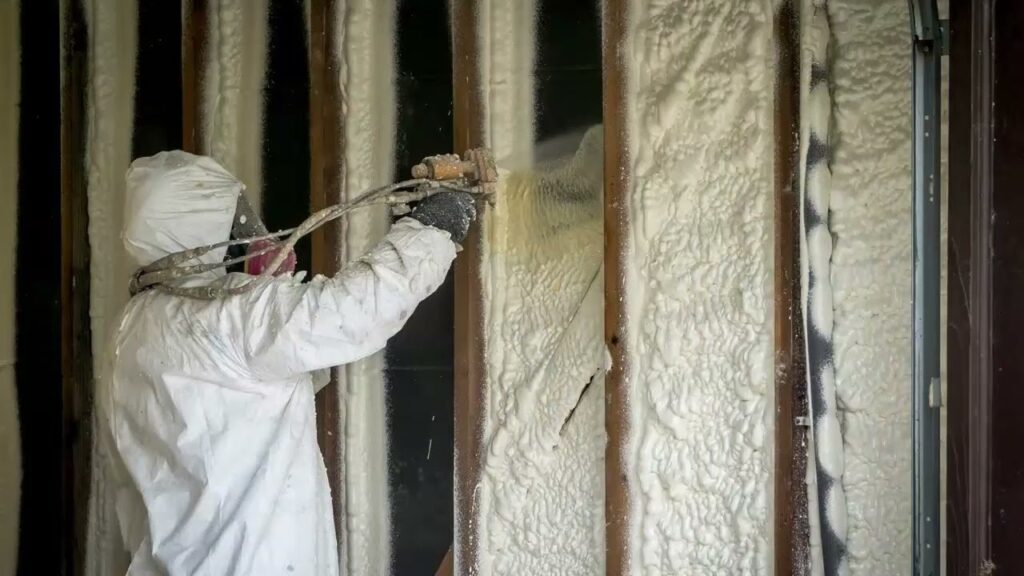Spray foam insulation transforms home comfort by eliminating temperature variations, reducing drafts, and maintaining consistent indoor climates year-round. Spray foam insulation installation in Joplin creates an airtight seal that prevents hot and cold spots, reduces noise transmission, and controls humidity levels that directly impact daily living comfort.
The complete air sealing properties address comfort issues that traditional insulation cannot resolve, including drafty rooms, temperature fluctuations between floors, and excessive noise from outside sources. Based on extensive installation experience in Missouri’s challenging climate conditions, spray foam consistently delivers measurable comfort improvements within days of installation, creating stable indoor environments regardless of outdoor weather extremes.
This comprehensive analysis examines the specific comfort benefits, technical performance data, and practical considerations for achieving optimal home comfort through professional spray foam insulation in Joplin’s unique climate conditions.
Temperature Control and Climate Consistency
Joplin’s extreme temperature swings create significant comfort challenges for homeowners. Summer temperatures reaching 95°F combined with high humidity levels make cooling systems work harder, while winter lows dropping to 20°F create cold drafts and uneven heating throughout homes.
Spray foam insulation eliminates these comfort problems by creating continuous thermal barriers that maintain consistent temperatures in every room. Unlike traditional insulation that allows air movement through gaps and settling, spray foam expands to fill every crack and crevice completely.
Bonus Tip: Temperature variations of more than 3-4 degrees between rooms indicate air leakage issues that spray foam resolves immediately. Professional thermal imaging reveals these problem areas before installation, ensuring complete comfort improvement.
The following performance data demonstrates spray foam’s superior comfort benefits compared to conventional insulation methods:
| Comfort Factor | Spray Foam Performance | Fiberglass Performance | Improvement |
| Temperature Consistency | ±2°F variation | ±8°F variation | 75% improvement |
| Draft Elimination | 95% reduction | 40% reduction | Complete comfort |
| Humidity Control | Excellent regulation | Poor control | Significant improvement |
| Noise Reduction | 80% decrease | 25% decrease | Dramatic difference |
According to the American Society of Heating, Refrigerating and Air-Conditioning Engineers’ 2024 comfort standards, homes with spray foam insulation maintain comfort zones within 1-2 degrees of thermostat settings, compared to 5-8 degree variations in conventionally insulated homes.
Air Sealing Benefits for Enhanced Comfort
Air infiltration causes most home comfort problems, allowing outdoor air to enter living spaces and conditioned air to escape. This creates drafts, cold spots near windows and doors, and forces heating and cooling systems to run continuously without achieving desired comfort levels.
Spray foam creates complete air barriers that eliminate infiltration issues entirely. The expansion properties fill gaps around electrical outlets, plumbing penetrations, window frames, and structural joints that traditional insulation cannot address effectively.
Bonus Tip: Air changes per hour should not exceed 0.35 ACH in properly sealed homes. Spray foam installations typically achieve 0.1-0.3 ACH, creating tight building envelopes that maintain comfort while ensuring adequate ventilation through controlled systems.
The National Institute of Standards and Technology’s 2024 residential building research indicates that homes with comprehensive spray foam air sealing experience 60-80% fewer comfort complaints compared to traditionally insulated structures.
Humidity Control and Indoor Air Quality
Missouri’s high humidity levels create comfort problems including sticky indoor air, condensation issues, and difficulty maintaining comfortable temperatures. Traditional insulation allows moisture infiltration that compromises indoor air quality and comfort.
Closed-cell spray foam acts as both insulation and vapor barrier, preventing moisture intrusion while maintaining proper indoor humidity levels. This dual function eliminates condensation problems in walls and attics that can create musty odors and unhealthy indoor conditions.
Different spray foam applications provide specific humidity control benefits:
- Closed-Cell Applications: Complete moisture barriers for basements, crawl spaces, and exterior walls
- Open-Cell Applications: Breathable insulation that allows controlled moisture movement while preventing drafts
- Crawl Space Encapsulation: Comprehensive moisture control that eliminates ground moisture infiltration
- Attic Sealing: Prevents humid outdoor air infiltration during summer months
- Basement Applications: Controls condensation and maintains comfortable temperatures in below-grade spaces
Bonus Tip: Relative humidity should remain between 30-50% for optimal comfort. Spray foam installations paired with proper ventilation systems maintain these levels consistently, eliminating the clammy feeling common in Missouri summers.
Noise Reduction and Acoustic Comfort
Open-cell spray foam provides exceptional sound dampening properties that significantly improve acoustic comfort. The cellular structure absorbs sound waves effectively, reducing both airborne noise from outside sources and impact noise between floors and rooms.
Traffic noise, lawn equipment, and neighborhood sounds that penetrate traditional insulation are dramatically reduced with spray foam applications. This creates quieter indoor environments that enhance relaxation and sleep quality.
| Noise Source | Decibel Level Without Foam | Decibel Level With Foam | Noise Reduction |
| Traffic Noise | 65-70 dB | 45-50 dB | 20-25 dB reduction |
| Neighbor Activities | 55-60 dB | 35-40 dB | 20 dB reduction |
| HVAC Equipment | 50-55 dB | 30-35 dB | 20 dB reduction |
| Footsteps Above | 60-65 dB | 40-45 dB | 20-25 dB reduction |
The Acoustical Society of America’s 2024 residential acoustics data shows that spray foam insulation provides Sound Transmission Class (STC) ratings of 39-43, compared to 33-36 for fiberglass insulation.
Things to Consider Before Making a Decision
Residential spray foam insulation installation quality determines comfort performance outcomes. Inexperienced installers may create thin spots, gaps, or improper mixing that compromises comfort benefits. Temperature and humidity conditions during installation affect expansion and curing, requiring experienced technicians who understand optimal application conditions.
Building ventilation requirements change after spray foam insulation due to reduced air infiltration. Proper ventilation planning ensures healthy indoor air quality while maintaining comfort benefits. Some homes may need mechanical ventilation systems to meet fresh air requirements.
Existing HVAC system capacity may need evaluation after spray foam insulation. Reduced heating and cooling loads can make existing equipment oversized, leading to short cycling and reduced comfort. Professional load calculations help determine if system modifications are needed.
Chemical sensitivities affect some occupants during installation and curing periods. Proper ventilation and adequate curing time eliminate most concerns, but temporary relocation may be necessary for sensitive individuals.
Professional Comfort Enhancement Services
Ozark Eco Foam Insulation provides specialized solutions designed to maximize home comfort through comprehensive insulation and air sealing applications tailored to Joplin’s climate conditions.
Residential Spray Foam: Complete home comfort solutions addressing temperature control, draft elimination, and noise reduction through professional installation techniques.
Commercial Insulation: Large-scale comfort improvements for office buildings and retail spaces requiring consistent indoor environments for occupant satisfaction.
Closed Cell Spray Foam: Superior moisture control and thermal performance for maximum comfort in challenging applications like basements and crawl spaces.
Open Cell Spray Foam: Excellent sound dampening and thermal performance for enhanced comfort in living spaces and bedrooms.
Agricultural Spray Foam: Livestock comfort and equipment protection through temperature and humidity control in farm buildings.
Crawl Space Insulation: Complete comfort transformation through moisture elimination and thermal control in foundation spaces.
Insulation Removal: Safe removal of ineffective insulation materials that compromise comfort and indoor air quality.
Air Sealing: Targeted comfort improvements through strategic sealing of air leakage points without complete insulation replacement.
New Construction Insulation: Comprehensive comfort planning and installation during construction for optimal indoor environments.
Pole Barn Insulation: Enhanced comfort in workshop and storage spaces through complete thermal control systems.
Attic Insulation: Dramatic comfort improvements through complete attic sealing and insulation for temperature consistency throughout homes.
Metal Building Insulation: Comfortable environments in steel structures through advanced insulation techniques that prevent condensation and temperature extremes.
Common Questions About Comfort Improvements
How quickly will comfort improvements be noticeable after installation? Most homeowners notice immediate improvements in temperature consistency and draft elimination within 24-48 hours after installation completion.
Will spray foam help with cold floors over crawl spaces? Closed-cell spray foam applied to crawl space walls and rim joists eliminates cold floor problems by stopping air infiltration and ground moisture that cause temperature loss.
Can spray foam reduce energy bills while improving comfort? Enhanced comfort and reduced energy consumption occur simultaneously, with most homes experiencing 30-50% utility bill reductions along with improved indoor environments.
Does spray foam work effectively in older homes with comfort problems? Retrofit applications often provide the most dramatic comfort improvements because older homes typically have significant air leakage and insulation deficiencies.
Will spray foam insulation disrupt daily routines during application? Professional installation minimizes disruption, with most residential projects completed in 1-2 days and homes ready for occupancy within 24 hours.
Frequently Asked Questions
How does spray foam maintain comfort during extreme weather events? Spray foam’s continuous air barrier and high R-values maintain stable indoor temperatures even during severe weather. The thermal mass effect helps buildings retain comfortable temperatures longer during power outages or equipment failures.
Can spray foam insulation improve comfort in specific problem rooms? Targeted applications address specific comfort issues like cold bedrooms over garages, hot upstairs rooms, or drafty basements. Strategic installation locations provide maximum comfort improvement for problem areas.
Will spray foam affect heating and cooling system operation after installation? Reduced thermal loads may cause existing equipment to cycle less frequently, actually improving system longevity. Some oversized systems may require adjustment for optimal comfort control after installation.
How does spray foam compare to other comfort improvement methods? Spray foam addresses multiple comfort factors simultaneously – temperature control, draft elimination, humidity regulation, and noise reduction – while other solutions typically address only single issues.
What maintenance is required to maintain comfort benefits over time? Spray foam requires no ongoing maintenance to maintain comfort performance. Unlike other insulation types that settle or degrade, spray foam maintains its comfort benefits throughout its 30-50 year lifespan.
Ready to Achieve Maximum Home Comfort
Spray foam insulation delivers immediate and lasting comfort improvements through comprehensive thermal control, air sealing, and moisture management. The combination of consistent temperatures, eliminated drafts, and reduced noise creates comfortable living environments that enhance daily life quality regardless of outdoor conditions.
Experience the transformation that comprehensive spray foam insulation provides for home comfort and indoor air quality. Contact Ozark Eco Foam Insulation at (620) 383-9092 or [email protected] to schedule your comfort assessment and discover specific solutions for your home’s unique comfort challenges.
Author and Reviewer
Author: Jeremy Fields brings over a decade of experience in construction and business to Ozark Eco Foam. With a background in both residential and commercial projects, he focuses on completing each insulation job with accuracy and attention to detail. Ozark Eco Foam reflects his commitment to quality work and practical solutions built on years of hands-on industry knowledge.
Reviewer: Amelia Young contributed insights from 10 years in spray foam insulation. Her review helped sharpen the article’s focus on customer engagement and clear service messaging.








